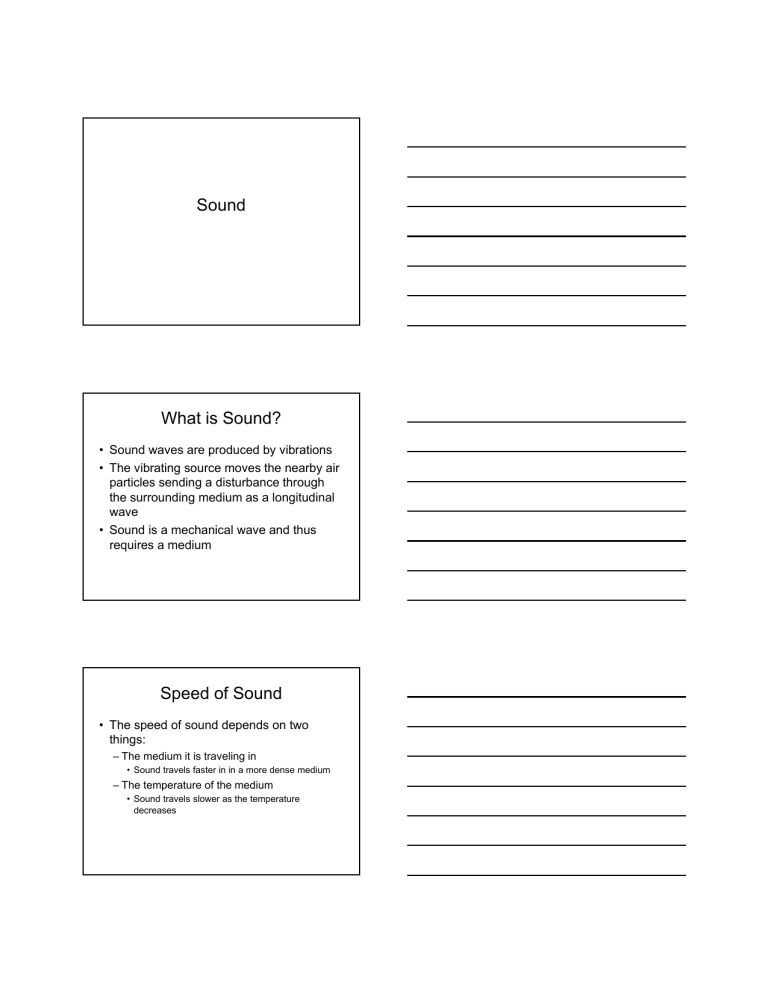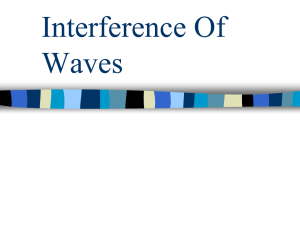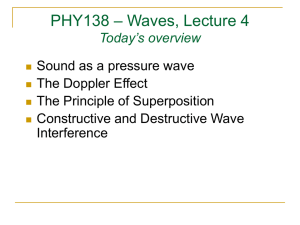Sound What is Sound?

Sound
What is Sound?
• Sound waves are produced by vibrations
• The vibrating source moves the nearby air particles sending a disturbance through the surrounding medium as a longitudinal wave
• Sound is a mechanical wave and thus requires a medium
Speed of Sound
• The speed of sound depends on two things:
– The medium it is traveling in
• Sound travels faster in in a more dense medium
– The temperature of the medium
• Sound travels slower as the temperature decreases
Speed of Sound in Air
v
331
0 .
6 T
• T is temperature in ºC
Speed of Sound in Various Media
Loud or Soft
• Variations in the pressure wave are detected by the ear and interpreted by the brain
• Higher pressure waves are louder
• This volume is related to the amplitude of the wave.
– Higher amplitude sound waves are louder
• Loudness is measured in decibels (dB)
• Humans can hear sounds in the frequency range of 20 – 22 000 Hz
– This varies with age
• Most human speech communication takes place between 200 and 8000 Hz
• The human ear is most sensitive to frequencies around 1000-3500 Hz.
• Other animals have different ranges
– Dogs: 40 Hz – 60 000 Hz
– Bats: 20 Hz – 120 000 Hz
– Mice: 1000 Hz – 90 000 Hz
• A change of 3 dB is the minimum change in sound level to be detected
– barely noticeable
• A change of between 6 dB and 10 dB is perceived as a doubling (or halving of volume)
Source
Weakest sound heard
Level
(dB)
0
Whisper Quiet
Library
Normal conversation (3-
5')
Telephone dial tone
City Traffic (inside car)
Train whistle at
500', Truck Traffic
30
60-70
80
85
90
Source
Level at which sustained exposure may result in hearing loss
Level
(dB)
90 - 95
Power mower at
3'
Snowmobile,
Motorcycle
Power saw at 3’
107
100
110
Source
Even short term exposure can cause permanent damage -
Loudest recommended exposure WITH hearing protection
Jet engine at
100', Gun Blast
Death of hearing tissue
Level
(dB)
140
140
180
Loudest sound possible
194
Loud Rock
Concert
Pain begins
115
125
Doppler Effect
• When a source of sound is moving towards you (or you moving towards the source), the frequency of the sound appears to increase
• When a source of sound is moving away from you (or you moving away from the source), the frequency of the sound appears to decrease
• This is known as the Doppler Effect http://www.kettering.edu/~drussell/Demos/doppler/doppler.html
Resonance
• Resonance occurs when an object is made to vibrate at its natural vibration frequency
– Musical instruments use resonance to produce their sound
• Resonance is a problem if a building (or bridge) vibrates at its natural frequency
– It will collapse
Standing Waves
• When two waves of the same speed and wavelength and equal or almost equal amplitudes traveling in opposite directions meet, a standing wave is formed.
• The wave is result of the superposition of the two waves traveling in opposite directions.
Special Terms
• Node
– Points where the displacement is always zero
• Antinode
– Displacement is a maximum
– Note: the maximum is not always the same maximum
• When resonance occurs standing waves form in specific patterns or modes
• The first mode of vibration has the lowest frequency.
• This first mode is known as the fundamental or first harmonic .
• Each mode after is known as a harmonic
– Second, third, fourth…
• Each harmonic is an interval of the fundamental
– f
2
= 2f
1
– f
3
= 3f
1
– f
4
= 4f
1
Standing Waves on a String
• There is a node at each end where the string is attached.
• First harmonic (fundamental) f
1
v
1
L
1
2
1
2 L f
1
v
2 L
• Second harmonic
L
2
2
2 f
2
v
2
2
2 L
2 f
2
2 v
2 L
2 f
1
• Third harmonic f
3
v
3
L
3
3
2
3
2 L
3 f
3
3 v
2 L
3 f
1
Standing Waves in an Open Pipe
• An open pipe (open at both ends) behaves similarly to a string
• First harmonic (fundamental)
L
1
2 f
1
v
1
f
1
v
2 L
1
2 L
• Second harmonic
L
2
2
2 f
2
v
2
2
2 L
2 f
2
2 v
2 L
2 f
1
• Third harmonic f
3
v
3
L
3
3
2
3
2 L
3 f
3
3 v
2 L
3 f
1
Standing Waves in a Closed Pipe
• A pipe that is closed at one end has a node at the closed end and an antinode at the open end
• First harmonic (fundamental)
L
1
4 f
1
v
1
f
1
v
4 L
1
4 L
• Third harmonic
L
3
3
4 f
3
v
3
3
4 L
3 f
3
3 v
4 L
3 f
1
• Fifth harmonic
L
5
5
4 f
5
v
5
5
4 L
5 f
5
5 v
4 L
5 f
1
Interference
• When two sound waves meet they interfere with each other (superposition)
• When the principle of superposition is applied, we have areas of constructive and destructive interference
• The human ear detects this as “beats”
• The frequency of the beats (beat frequency) is the difference between the frequencies of the waves
Wave 1
Wave 2
Waves 1 + 2
Waves 1 + 2
• If the combining waves have the same frequency and amplitude, then total destructive interference (heard as silence) will occur if the waves are completely out of phase
– In other words a crest lines up with a trough
• Interference can also occur when waves are emitted from two sources
• The waves combine in the air forming areas of destructive and constructive interference
• Total destructive interference (silence) will occur if the two waves are completely out of phase
• Sound people must keep this in mind when setting up sound systems for concerts or in auditoriums
• Constructive interference will occur when the difference in path lengths from each source to a point differs by a factor of one wavelength
PS
1
PS
2
n
• Destructive interference will occur when the difference in path lengths from each source to a point differs by a factor of onehalf wavelength
PS
1
PS
2
1
2
• Constructive interference (A, B, C, D)
– antinodes
• Destructive interference (E)
– nodes




